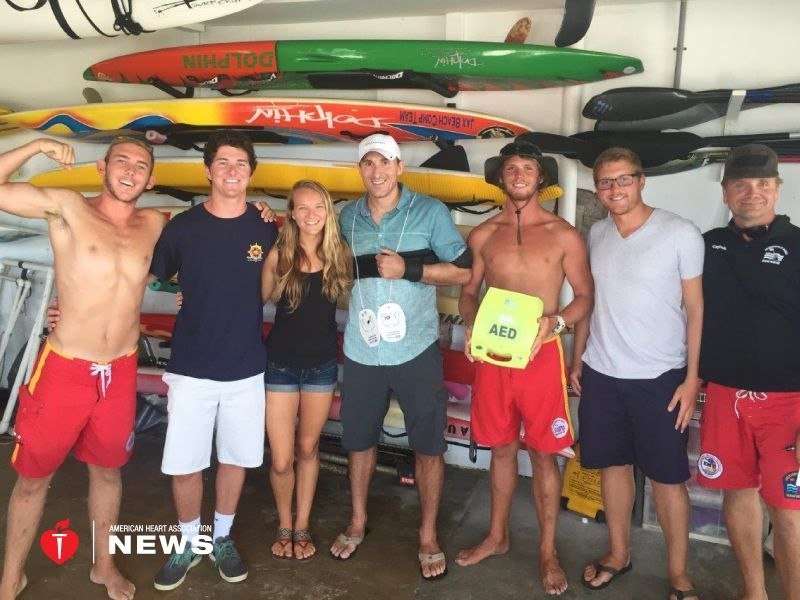AHA: Florida lifeguards helped save man's life after cardiac arrest

For J.R. Bourne, a day at the beach rekindles good and bad memories.
It's the place where the Jacksonville Beach, Florida, resident died and was brought back to life thanks to fast-thinking first responders and an automated external defibrillator.
Back in June 2015, then-40-year-old Bourne was playing soccer on the beach with his friend Luis when he suddenly collapsed and stopped breathing.
A bystander immediately started CPR and someone called 911. Luckily, lifeguards on a Jacksonville Beach Ocean Rescue truck were nearby.
"We were driving down the beach at 10 a.m., putting our lifeguards out on towers, when we heard screams for help," said lifeguard Gordon VanDusen, one of the first responders. The lifeguards are certified in CPR and AED, and had just completed refresher training.
Within seconds the lifeguards took over CPR. They used an AED to shock Bourne's heart back to a normal rhythm. The team of eight kept him breathing until an ambulance arrived.
More than 350,000 people in the U.S. experience a cardiac arrest outside of a hospital each year. Cardiac arrest occurs when the heart's electrical system malfunctions, causing the heart to abruptly stop. Unless CPR is performed and an AED is used to shock the heart, death can occur within minutes.
At Mayo Clinic Jacksonville, Bourne learned he was among the 11 percent of those treated by emergency medical services to survive a cardiac arrest.
Bourne's wife, Pam, recalled a hospital doctor saying, "On a scale of one to 10, his luck was a 30 today."
Bourne spent six days at the hospital, undergoing tests and surgeries.
Cardiac catheterization found no blockage in his arteries, but an echocardiogram and MRI showed scarring on 20 percent of his heart. His ejection fraction score a measure of how well the heart pumps blood was 25. A normal reading is 50 or higher.
Bourne's official diagnosis was hypertrophic cardiomyopathy, a thickening of the heart muscle that can disrupt the electrical signals and heartbeat. It's a common condition that's usually inherited, but the cause is unknown.
HCM could have caused Bourne's heart to stop. Vigorous physical activity can trigger arrhythmias, which can lead to cardiac arrest in people with HCM.
Bourne received an implantable cardioverter defibrillator, or ICD, because his risk for another cardiac arrest remained high. The pocket-watch-size device implanted in his chest monitors his heart rate and delivers a shock if it detects an irregular rhythm.
Bourne's new ICD was put to the test six months later while playing golf. He passed out and "felt like someone punched me in the chest when I wasn't expecting it." After a visit to the hospital, he learned his ICD shocked him when his heart rate jumped to 288 beats per minute. A normal heart rate is 60 to 100 beats per minute.
"They identified what happened, but not why," Pam said. "We don't take the luck thing lightly."
Since then, the couple have become certified in CPR and AED. They also volunteer with the American Heart Association, and Bourne joined the board of the American Red Cross Jacksonville Beach Volunteer Life Saving Corps.
"It's important," Bourne, now 43, said. "AEDs should be as common as fire extinguishers."
Copyright is owned or held by the American Heart Association, Inc., and all rights are reserved. If you have questions or comments about this story, please email editor@heart.org.















